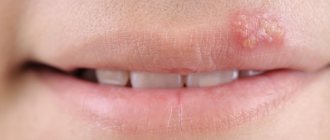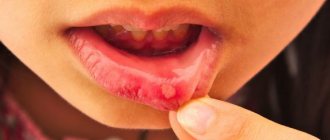Causes of stomatitis
The imperfection of local and general defenses of the child’s body makes the mucous membranes of the oral cavity vulnerable to adverse factors. And the healthy curiosity characteristic of every child has made stomatitis one of the most common diseases among children. Sometimes, for the development of an illness, it is enough to taste any less than sterile object. The main causes of the disease include the following:
- insufficiently good oral hygiene;
- minor injuries - cheek biting, scratch, etc.;
- burns, including chemical burns;
- exposure to pathogens from unwashed hands or dirty toys.
Dentists focus on stomatitis associated with biting the inside of the cheek.
This is often associated with recent dental treatment under local anesthesia. For some time after the procedure, there is reduced sensitivity in the area of the lip or cheek, so you need to eat food after treatment very carefully and only after you have waited for the recommended period of time - usually from 1 to 2 hours. The likelihood of developing stomatitis for these reasons increases after infectious diseases, previous interventions, hypothermia and other factors that contribute to a decrease in protective forces.
Possible complications
Primary infection with herpetic stomatitis is highly treatable. Within 7-10 days, with proper treatment, the child can fully recover. Without appropriate drug therapy, the following complications may develop:
- herpetic keratoconjunctivitis (a dangerous herpetic eye infection that leads to blindness);
- dehydration (due to refusal to eat and drink).
To avoid undesirable consequences, it is necessary to consult a doctor at the first symptoms of the disease, strictly adhere to all instructions, give the baby plenty of fluids, monitor oral hygiene, and wash your hands after each treatment of a surface affected by herpes.
Types of stomatitis
The treatment regimen for stomatitis in children is based on the type of disease. There are several types of stomatitis:
- bacterial;
- viral, including herpes;
- fungal;
- aphthous;
- angular;
- allergic;
- traumatic.
All types of stomatitis occur in children, but the most common among children under 3 years of age are aphthous, candidal, herpetic and allergic. An increase in the incidence of traumatic stomatitis is usually associated with a period of active growth of primary teeth.
It is important to understand that in some cases, stomatitis is combined with other diseases with similar symptoms and is the first sign of more serious diseases. For example, with cheilitis - inflammation of the mucous membrane and red border of the lips, food allergies, etc.
Symptoms
Common symptoms of stomatitis are pain, burning, swelling of the mucous membrane and redness, and bad breath. Salivation also changes - it can be excessive or insufficient, with dry mouth. In some cases, there may be an increase in temperature and enlargement of the submandibular lymph nodes.
The types of stomatitis in children and treatment methods differ, as do the specific manifestations. For example, with aphthous stomatitis, only one large ulceration may appear, but with viral stomatitis, inflammation almost always takes the form of numerous elements or a rash merging into one focus.
Candidal stomatitis is characterized by the formation of a white or yellowish cheesy coating. It is easier to recognize traumatic stomatitis because it is preceded by damage or the source of injury is nearby - a chipped tooth or a rough filling.
“Mom, my mouth hurts!” We talk about stomatitis in children
Is your child being capricious, refusing food, or complaining of pain in the mouth? One of the reasons for this condition may be stomatitis. Alla Aleksandrovna Zmanovskaya, a dentist at Clinic Expert in Irkutsk, told us about the signs of stomatitis in children, methods of diagnosing and treating it.
— Alla Alexandrovna, what is stomatitis?
This is an inflammation of the mucous membrane of any part of the oral cavity - lips, cheeks, tongue, palate, gums.
— Why does stomatitis occur in children?
One of the reasons for the development of stomatitis may be damage to the mucous membrane as a result of mechanical and chemical trauma. There are frequent cases of injury to the mucous membrane by sharp edges of teeth. One type of stomatitis, Bednar's aphthae, develops due to trauma to the oral cavity from a rough pacifier. The availability of household chemicals to a child can cause a chemical burn to the oral cavity.
Viral, bacterial and fungal stomatitis develop against the background of infection with pathogens of ARVI, influenza, herpes, measles, rubella, specific infections (tuberculosis, syphilis, etc.), with weakened immunity, with pathology of certain organs and systems, in particular the gastrointestinal tract , as well as for allergic reactions. Fungal stomatitis can develop due to the use of antibiotics.
— Tell us about the existing types of stomatitis in children and their differences
There are acute and chronic forms of this pathological process. Depending on the elements of tissue damage, catarrhal, ulcerative and aphthous stomatitis are distinguished. They differ from each other both in symptoms and severity, and in treatment tactics.
Acute herpetic stomatitis is a common type of disease in children aged 6 months to 3 years. During this period, children lose antibodies received from the mother while the fetus is in the womb, and their own immunity is not yet ready for an adequate response. With age, there is a decrease in the incidence of this form of stomatitis due to the development of acquired immunity after suffering various forms of herpetic infection.
Infants and children who have undergone long-term antibiotic therapy often develop candidal stomatitis.
— What are the symptoms of stomatitis in children?
Parents may notice rashes on the oral mucosa - blisters, spots, ulcers, erosions, and feel bad breath. Young children become more capricious and refuse foods that especially irritate the inflamed mucous membrane (sour, salty). An older child usually points to the place where it hurts. With more severe stomatitis in children, body temperature may increase. Detection of these signs is a good reason to immediately contact a pediatric dentist.
— What is the diagnosis of stomatitis in children based on?
To make a diagnosis, we first talk with the adults accompanying the child - we find out the complaints, clarify when and how the disease began, how long it has lasted, and what chronic pathologies the child suffers from. Then we move on to examining the oral cavity, recording all changes in the mucous membrane and teeth. An external examination of the maxillofacial area is also carried out. In severe cases of some types of stomatitis in children, rashes on the lips and enlarged regional lymph nodes can be detected.
— What methods of treating stomatitis in children are currently relevant?
Depending on the severity of the disease, local or complex treatment is used. For example, in the case of the development of stomatitis as a result of mechanical damage, it is sufficient to eliminate the action of the causative factor (avoid the use of rough nipples, grind off sharp edges of teeth, etc.), antiseptic treatment of the oral cavity and the use of drugs for regeneration of the mucous membrane against the background of complete sanitation and elimination of the damaging factor a. For chemical burns, depending on the severity, hospitalization is indicated.
For viral, bacterial and fungal stomatitis of moderate and severe severity, in addition to local treatment, antiviral, antifungal or antibacterial therapy is additionally prescribed.
For any form of stomatitis, children should limit their consumption of coarse, hard, irritating foods.
Based on how long it takes for a child’s stomatitis to go away, we can draw a conclusion about the effectiveness of the treatment used and, if necessary, adjust it. Any form of stomatitis is cured within one to two weeks. However, it should be remembered that a feature of stomatitis in an HIV-infected child is that its course, even with appropriate treatment, is delayed for more than 2 weeks.
— Alla Alexandrovna, is it possible to prevent the development of stomatitis?
Can. The main method of prevention is sanitation of the oral cavity, which involves treatment of all teeth affected by caries and its complications, regular thorough oral hygiene, disinfection of premises, household items, and toys.
If a child often has stomatitis, you should consult a dentist and pediatrician, who, if necessary, will prescribe a comprehensive examination. It is important that children receive a nutritious, balanced diet and spend a lot of time outdoors. Hardening the body and playing sports also help the body resist infections.
If you suspect or detect signs of stomatitis in a child, I recommend that you contact a pediatric dentist. By eliminating possible causes and choosing the right therapy, the doctor will be able to prevent oral inflammation from becoming chronic.
For reference:
Zmanovskaya Alla Alexandrovna
In 2015 she graduated from the Faculty of Dentistry of Irkutsk State Medical University.
In 2016, she completed her internship at the Federal State Budgetary Educational Institution ISMU in the specialty “General Dentistry”.
In 2016, she underwent professional retraining at the Federal State Budgetary Educational Institution ISMU in the specialty “Therapeutic Dentistry”, in 2022 – in the specialty “Pediatric Dentistry”.
Dentist-therapist, pediatric dentist at “Clinic Expert” Irkutsk. Receives at the address: Irkutsk st. Kozhova, 9a
Diagnostic features
A dentist can detect stomatitis during the first visual examination. But in controversial cases, laboratory tests may be required. Thus, bacterial inflammation may require identification of the causative agent of the disease and its sensitivity to antibiotics. A scraping and/or virological study will help determine the cause of the disease and prescribe appropriate treatment.
If a combination of several ailments with a similar picture is suspected, as well as if the child’s general well-being deteriorates, laboratory tests of blood and urine and consultations with other specialists may be prescribed.
Sometimes stomatitis can be the first manifestation of systemic diseases, general somatic pathology, for example, diabetes mellitus or malignant neoplasms. Therefore, a timely visit to the doctor is extremely important.
Features of treatment
As is often the case with diseases that are at the intersection of several areas of medicine, inflammatory lesions of the oral mucosa are one of the least studied areas of dentistry. Therefore, several specialists can be involved in the treatment of stomatitis in children in the mouth: pediatrician, dentist, dermatologist, immunologist-allergist, otolaryngologist, etc. This is especially convenient when you go to a multidisciplinary clinic.
Self-medication of stomatitis is unacceptable, and although it is now easy to find ready-made treatment regimens and folk recipes, it is important not to experiment with the baby’s health.
Conservative treatment is mainly used, which involves treating the underlying cause of the disease. Your doctor may prescribe the following medications:
- antibacterial drugs (systemic and local in the form of ointments): for bacterial inflammation;
- antiviral agents for herpes and other types of viral stomatitis;
- antifungal drugs for fungal diseases;
- antihistamines - both for allergic origin of stomatitis, and as part of complex therapy to reduce swelling and itching;
- symptomatic drugs - anti-inflammatory, analgesic, antipyretic.
Treatment of candidal stomatitis in infants should be carried out with caution. At the same time, it is important to pay attention to your health; sometimes the cause of such a disease can be insufficient breast hygiene during lactation.
Often, only local remedies are sufficient, but make sure that the entire oral cavity is treated with the rinse - inflammatory agents can be found on the entire surface of the mucous membranes. Healing applications can be used to a limited extent, only on areas of inflammation.
Treatment of stomatitis of any kind in children involves strict adherence to a diet. The diet should be gentle, it is important to avoid salty, spicy, sour foods and drinks, serve the child warm meals, and limit the consumption of sweets.
If traumatic stomatitis occurs, the doctor will prescribe medications to speed up healing. However, it is very important to prevent re-injury. If it was caused by sharp edges of a tooth or filling, this cause should be eliminated. The doctor will suggest grinding off the filling or replacing it, and will also choose the appropriate option for restoring the shape of the crown in case of chips and cracks.
Prevention of stomatitis
You can reduce the risk of developing stomatitis using the following recommendations:
- regular washing of toys, bottles, pacifiers, breast hygiene if the baby is breastfed;
- general strengthening activities: walks, wet cleaning, a balanced diet, moderate hardening, adherence to a daily routine;
- fighting bad habits of biting nails, pencils, etc.;
- regular dental examinations and timely interventions in case of dental injuries.
The dentists of the Family Doctor clinic treat and prevent stomatitis in children.
Advanced equipment allows us to quickly and accurately assess the condition of the oral cavity and perform the necessary studies in a short time. We practice modern approaches to the treatment of inflammatory diseases of the oral cavity and adhere to an individual approach to each small patient. Consultations with a pediatric dentist are available by appointment. To make an appointment, call the single contact center or fill out a special online appointment form with a pediatric dentist on the website, or you can also visit the clinic’s reception in person.
What do doctors advise for home care?
The specialist makes a diagnosis and prescribes treatment, and the implementation of all instructions falls entirely on the shoulders of the parents. Caring for a small child with stomatitis contains many nuances. For example, during this period you should feed your baby only warm food with a mushy consistency, excluding citrus, sour and spicy foods. After eating, be sure to rinse your mouth. If the baby is still very small, then after eating you should give him a little boiled water to drink. Treatment of the oral cavity and application of gels prescribed by a doctor should be done with a special fabric fingertip or a finger wrapped in a bandage (the bandage should then be thrown away).
Important: self-medication is dangerous. Only a doctor can correctly diagnose and give the correct therapeutic recommendations.









